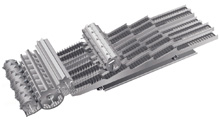
Features
Agronomy
Other Crops
Row spacing less important than good agronomics
Worry less about row spacing and more about getting a good plant stand.
November 29, 2007 By Ralph Pearce
Row spacing, seeding rate and hybrid versus open-pollinated cultivars can affect
everything from plant stand density through to disease infestation and ultimately
yield. But pinning down a prescription for the best agronomic package is not
likely going to happen, according to a number of researchers who took part in
a two site, three year study funded by the Alberta Canola Producers' Commission
and the Saskatchewan Canola Development Commission. Researchers Byron Irvine,
Randy Kutcher, Kelly Turkington and Neil Harker took part in two separate studies
into the impact of seeding rate and row spacing on canola.
 |
| A nine inch row spacing generally gave the highest yield. |
The two sites involved were at Melfort, Saskatchewan and Lacombe, Alberta,
during the 2002 to 2004 growing seasons. Four row spacings of nine, 12, 18 and
24 inches were used with three seeding rates of 0.5, 1.0 and 1.5 times the normal
rate of five pounds per acre (6kg/ha). Open-pollinated and hybrid cultivars,
both of which were glyphosate tolerant, were planted into the plots with a direct
seeding system.
Among the impacts studied were days to first flower, lodging, plant population,
percentage green seed, thousand-seed weight and of course, yield. The canola
was seeded into cereal stubble using two ConservaPak seeders. Normal fertility
applications were used on the sites. Both cultivars were treated with Vitavax
RS before planting. Pre-seed burndown and an in-crop application of glyphosate
were used. In 2003, the Lacombe site also required hand weeding.
Use caution when interpreting results
Overall, yield at the nine inch (23cm) row spacing seemed best, says Kutcher,
a research scientist with Agriculture and Agri-Food Canada's Crop Diversification
and Environmental Stewardship Centre at Melfort. "The row spacing tended
to have a large effect and basically, the nine inch row spacing was the best
yielder or at least equal to the other row spacings," says Kutcher.
"As we increased row width at some site years, there was no difference
in yield among row spacings but essentially over the six site years, we observed
reduced yields with wider row spacings," he explains.
One of the big challenges in the Melfort and Lacombe projects was trying to
determine the impact of row width on sclerotinia stem rot. Kutcher found that
as row spacing increased as a means of reducing the density of the canopy, so
too did the risk of lodging, which by consequence raised the risk of sclerotinia
stem rot. "The unfortunate part of this study is that we really don't have
enough sclerotinia stem rot to comment too much on the direct impact,"
says Kutcher.
An underlying note of caution from this research is that while row spacing
effects were observed, many other interactions are just as important, if not
more than row spacing. For example, yield was greater for the hybrid than the
open-pollinated type in drier conditions, yet the open-pollinated fared better
under normal moisture conditions. That leads to the need for a greater understanding
of all the agronomic factors involved in canola production. But one thing is
clear: establishing a good plant stand is key for optimum canola yields.
"You need to do the best possible job of getting all your seed up uniformly,
making sure the flea beetle doesn't deal a death blow to you, and handling your
weeds early," says Irvine, a scientist in Integrated Agricultural Management
at Agriculture and Agri-Food Canada's Land Resources Management Centre at Brandon,
Manitoba. "If you do those things, it's probably more important than changing
row spacing in the seven to 12 inch range."
 |
| The 24 inch row spacing caused greater lodging and the potential for more disease. |
In addition to the Melfort and Lacombe studies, Irvine notes additional research
has been done at Swift Current and Scott, including work with irrigated plots,
as well as work by the Prairie Agricultural Machinery Institute. All of these
indicated very little impact on six to 16 inch row spacing, yet Irvine points
out that Swift Current and Scott are typically drier areas and not the traditional
canola growing regions. "I've always maintained that a good operator with
a good set-up, who takes care of his or her management would probably do a good
job, pretty much across a wide range of seeding equipment," says Irvine.
Irvine first became interested in the effects of narrow row spacing after reading
a report on work done in the early 1980s, which professed 'tremendous' advantages
to narrow row spacing. "But this was done in the days prior to decent weed
control, so they were hand weeding these plots which meant that narrow row spacings
were an advantage because by the time the plant's big enough to hand-weed, weeds
have already caused a lot of damage," he explains. As a result, the narrow
row spacings were better able to compete with early weed competition than the
wider row spacing. That may not be the case today, with early applications of
herbicides.
In other research by Guy Lafond, a production system agronomy scientist with
Agriculture and Agri-Food Canada's research farm at Indian Head, Saskatchewan,
an added benefit of shifting to banded nitrogen application in all the different
row spacings was found. This piece of the puzzle stresses the importance of
fertilizer placement.
Another component of the Swift Current research included planting into taller
stubble with wider row spacing. Taller stubble generally resulted in higher
yield. "But we've tried that same research in Brandon and it hasn't shown
those advantages because it's more moist here. We don't have the same hot drying
winds here that they do in Swift Current."
Ultimately, for optimum canola production, fine-tuning stand establishment
will likely lead to the greatest benefit on yield – whether that is tinkering
with row spacing, seeding rates, insect control, or even managing seeding depth
better.